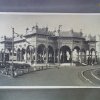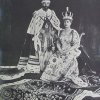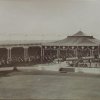DELHI DURBAR (1877, 1903, 1911)
There were three Delhi Coronation Durbars during the period of colonial rule that came into existence after the events of 1857. English monarchs were proclaimed Emperors of India in grand ceremonies that witnessed the coronation of Queen Victoria in 1877, King Edward VII in 1903 and King George V in 1911. The Durbars symbolised India being a part of the British Empire. Photography, a well-established art form and tool for documentation by the time of the first Durbar, aided and supplemented the virtual transference of its objective, generating and sustaining an endearing image of the Raj, glorifying its existence and celebrating its imagined legacy ‘with’ the larger colonized state and subject. Photography, however, was fated to mediate its ostensibly linear narrative as well. The enduring image has, since the time of the first Durbar, served to highlight, reorder and renegotiate the aesthetic and politics of this highly celebrated ‘ritual’, its context and meaning within the apparatus of colonial ideology and statecraft.
There is a large body of material, in the form of ornately decorated albums, rare publications and collections of images, archived in the Alkazi Collection, that bring these complex and engaging spectacles to light. The scholarly worth and scope of these visuals, mostly by way of photographic images and in some cases by way of sketches, watercolours and even lithographs and engravings, is extraordinary.
The first Delhi Durbar in 1877 symbolized the transfer of power and prestige from the erstwhile Mughal authority to a colonial entity, marking the beginning of a new era of imperial reign. Similarly, the reasons for holding the two succeeding Durbars were varied, exceeding their worth as established and ritualized ceremonies.
Durbars were large-scale productions that involved extensive preparations for constructing pavilions, making costumes for entertainment shows and organizing music and dance for the various invented rituals that were to be enacted and performed.
Durbars proved to be pivotal events in creating social and national memories of the Raj, of Princely states and their relationship with the colonial government. They represented, moreover, attempts by the British to seamless’, blend their rule into the legacy of the Mughal rulership, as their natural and worthy successors.
Some of the key concerns that these images bring up are with regard to ideology and state; the worth of spectacle for mass consumption and persuasion; the creation of imagined and invented identity. The plurality o’ ideas that they lend to extends to even issues of imperial culture, manners of an exhibition at the turn of the century and the art forms that the new colonial power patronized for their sustenance and consolidation.








